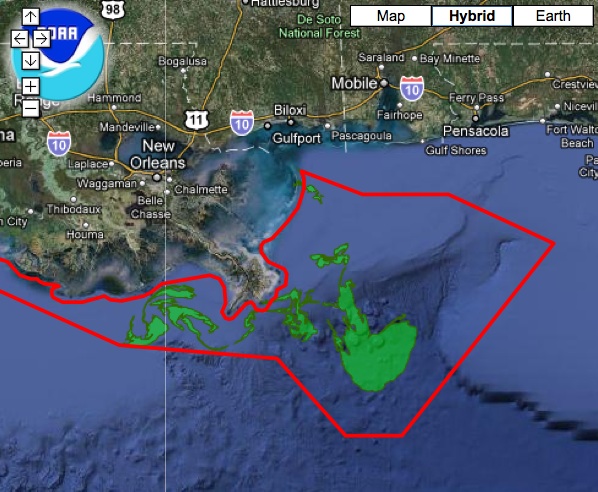Submitted by Anne Landman on
 Map of Gulf spill on May 8, with fishing closure areaAt first, right after the BP Deepwater Horizon offshore rig exploded on April 20, BP and U.S. government officials reported the underwater well was pumping about 1,000 barrels a day into the waters of the Gulf of Mexico. A few days later, that figure was challenged by the non-profit group SkyTruth, which uses remote sensing and digital mapping to evaluate environmental issues globally. Ten days later, by April 30, some industry experts said the well could be leaking at a rate of 5,000 barrels daily -- five times the previous estimate, and the one that has been the most widely and persistently used in the media.
Map of Gulf spill on May 8, with fishing closure areaAt first, right after the BP Deepwater Horizon offshore rig exploded on April 20, BP and U.S. government officials reported the underwater well was pumping about 1,000 barrels a day into the waters of the Gulf of Mexico. A few days later, that figure was challenged by the non-profit group SkyTruth, which uses remote sensing and digital mapping to evaluate environmental issues globally. Ten days later, by April 30, some industry experts said the well could be leaking at a rate of 5,000 barrels daily -- five times the previous estimate, and the one that has been the most widely and persistently used in the media.
Wildly Disparate Estimates
But estimates continue to change. On May 4th, BP executives in a closed-door meeting reportedly told Congress that the well is discharging anywhere from 5,000 to 60,000 barrels of oil into the Gulf per day. At 42 U.S. gallons per barrel, that means the spill could be growing by 210,000 to 2.52 million gallons of oil each day. But how much is that, really?
See For Yourself the Extent of the Disaster
Now we can all see exactly how much it is, and how fast the spill is growing, thanks to Google, who has started a Crisis Response Site for the Gulf spill that constantly maps the changing size, shape and location of the spill based on data from the State of Louisiana, the National Oceanic and Atmospheric Administration, and from satellite imagery. Google also lets you toggle on various maps showing the size and location of the spill on specific dates, where booms have been laid to protect the coast, and where spill-related incidents have occurred, like where the 30 or so dead turtles washed up on shore.
The Engineering Manager for Google Maps, Paul Rademacher, thoughtfully developed a Web site called "How Big is the Deepwater Horizon Oil Spill?" that allows people to take a current, up-to-date map of the spill and lay it over a map of their own city or area. This helps give people a sense of the spill's true size in the midst of widely-ranging official estimates that may or may not be true. You can lay the Gulf oil spill over London, Rome, San Francisco, Hawaii or Washington, D.C., or put it over your own town or state, to get an idea of it's true size, day by day. All you need is a free Google Earth plugin available free at the site.

Comments
WILLIAM LLOYD replied on Permalink
GULF OIL SPILL
Anne Landman replied on Permalink
Submit your idea to BP directly at these Web sites...
Zandonella replied on Permalink
May 30, 2010 Help on how
Anonymous replied on Permalink
This seems to be one of the
gaetano marano replied on Permalink
oil spill stop
Pages